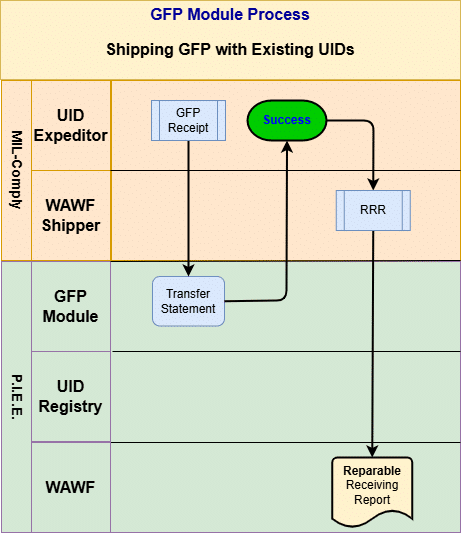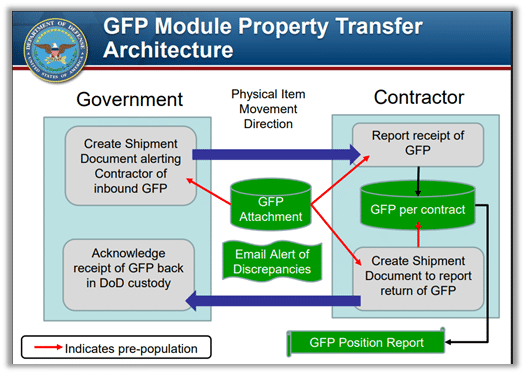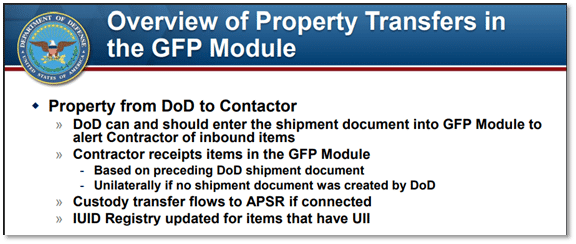The PIEE GFP Module performs numerous tasks managing government property that is temporarily in possession of contractors, going far beyond just UID-marked items. Its intersection with the MIL-Comply footprint, however, is limited to the management of contractor custody of UID-marked items provided to contractors for servicing of some type. During this process the contractor takes custody of such items via the GFP Module returning custody via the WAWF Reparable Receiving Report.
Prior to introduction of the GFP Module contractors transacted directly with the IUID Registry to acknowledge custody of items. In January 2025, the DOD began strict enforcement of DFARS 252.245-7005 requiring use of the GFP Module for the management of contractor custody requests. Part of its purpose is to ensure that contractors are authorized to have specific GFP items.
There are several interpretations of the term Government Furnished Property (GFP). The focus of most automation is UID-marked end-items provided to contractors to undergo maintenance, repair and overhaul (MRO) processing. This does not include equipment (GFE) lent for the purposes of contract execution, nor raw materials (GFM) that are used in manufacturing.
GFP UIDs submitted on a WAWF Reparable Receiving Report must first be transferred to the contractor’s custody in the IUID Registry. That action is performed in GFP Module, one of the PIEE web applications. Items that are not currently registered in the IUID Registry must be added to it, which can also be performed manually in PIEE.
The purpose of MIL-Comply’s UID Expeditor is to simplify the meeting of these DFARS requirements through the use of electronic data interchange (EDI) with the GFP Module and the IUID Registry. Once items are officially in contractor custody they may be submitted to WAWF via an EDI RRR and labeled in accordance with Mil-Std-129R for shipment.
Historical Perspective of the GFP Module
The purpose of GFP management as it pertains to contractor shipments is to ensure that custody of such UID-marked GFP items is accurately reflected in the IUID Registry. Contractors gain custody of items for servicing, then return the items to Government custody upon return shipment.
All of this can be performed using three related PIEE web applications; GFP Module, IUID Registry and WAWF. However, it is quicker and easier to use electronic data interchange (EDI) that integrates with your shipping process. Prior to January 2025 all of these GFP UID functions, along with part number rollover and lifecycle status changes, were handled by Direct-To-Registry transactions. Some of that functionality was decommissioned by the Government under 252.211-7007, partially replaced by the PIEE GFP Module.
The GFP process envisioned by the Government starts with a defense activity creating a shipping document in the GFP Module, which is transmitted to the contractor as an EDI Transfer Statement(TS). The contractor returns the TS to GFPM to acknowledge receipt of the items.
After MRO processing the items may be shipped on WAWF Reparable Receiving Reports (RRRs) which transfer custody of the items to the Government or another contractor.
Contractor-Initiated GFP Receipts
In the absence of a government-initiated shipment document (Transfer Statement) the contractor must initiate their own, using what is referred to as a Unilateral Receipt. Successfully completing this process allows WAWF to accept a Reparable Receiving Report from the Contractor for such items.
As of September 2025, Mil-Pac is unaware of contractors receiving DOD-generated shipping documents.
GFP Module for WAWF Reparable Receiving Reports

- A Receiver associated with a GFP contract/order is created and the item(s) added to it.
- The Receiver is submitted to the GFP Module with a GFPM Transfer Statement.
- A successful TS results in custody of the item(s) being transferred to the contractor in the UID Registry database.
- The items are included in a WAWF Reparable Receiving Report (RRR) for shipment to the Government (or another contract).
Note that items which have been received together may be shipped separately, so there may be multiple RRRs.
The process illustrated here and below show generation of the WAWF Reparable Receiving Report (RRR) for UID-marked GFP as performed by MIL-Comply.
Government-initiated GFP Transfers
Ideally, the Government creates shipping documents in GFP Module for inbound UID items, for which the contractor will receive email notice and an EDI Transfer Statement(TS). In such cases, the contractor will either simply acknowledge receipt by forwarding the TS to the Government marked as Received. This would replace Step 1 of the process described above. Mil-Pac has not encountered any such inbound notification Transfer Statements as of September 2025.
Adding GFP to the IUID Registry
GFP UID items that are not already in the IUID Registry will need to be added to it, as shown below. This requires transactions with both GFPM and the Registry and coordination between the two.
With MIL-Comply, the process is fairly straightforward.
- Create a Receiver with UID-marked GFP items
- Submit Receiver to the GFP Module as an EDI Transfer Statement
- If it is accepted, proceed with shipping items
- For items which GFPM reports as not in the UID Registry:
- Mark as Add to Registry (supplying the original acquisition cost of item)
- Resubmit (this transaction will be routed to the UID Registry )
- If items are added successfully:
- Resubmit the Receiver to GFPM
- Commence with shipment(s) upon success of TS
For Receivers with some items that require new UID Registration and some that do not, the latter are held in a pending state until the unregistered items are successfully added to the Registry.
Current Part Number (CPN)
Part number rollovers that occur during item maintenance or upgrade result in the assignment of a new part number as the item’s Current Part Number (CPN). This is sent to the GFP Module during the initial Receipt (Transfer Statement).
The new CPN is recorded in the item’s UID record in the Registry. The item’s UII itself does not change under any circumstance. It remains a part of the UID record.

The GFP Module migration from Direct-to-Registry changed the assignment of CPN somewhat. Prior to January 2025, updating a UID record’s CPN occurred only after custody was acknowledged by the UID Registry. With GFPM, it occurs at the time of Receipt. Therefore, an item’s revised part number must be known in advance.
It is unknown if the prior Direct-to-Registry method is still available, allowing for ad hoc part number rollovers. GFPM will definitely not accept a resubmission of a Transfer Statement (Receipt) for an item for the purpose of registering a CPN.




